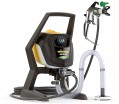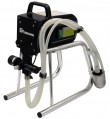Power consumption
The power consumed by the operation of an electric tool (see "Type").
Most modern spray guns, even performant ones, have a rather low power: for example, models
with more than 1 kW are extremely rare, and in most cases, power consumption does
not exceed 500 W at all. So when connecting such equipment to sockets, there are usually no problems; only single units of high performance, requiring 3.5 kW or more, have to be connected according to special rules (directly to the shield). In other cases, data on power consumption is most often not needed for normal use and may be required only for specific tasks — for example, to calculate the load on an autonomous generator.
Rated pressure
Nominal air pressure in the spray gun.
The general meaning of this parameter depends on the type of instrument (see above). So, in pneumatic models, nominal pressure data is required for connection to an external compressor. It is this pressure that this compressor must create at the inlet to the atomizer; too low values will lead to a decrease in efficiency, too high are fraught with breakdowns and even accidents with injury to others.
In turn, for electric models, the nominal pressure is the air pressure created by the unit's own compressor; the complete atomizer was originally designed for the same pressure. So in this case, this parameter is more of a reference than practically significant; it may be useful only for connecting replacement nozzles to the compressor (or vice versa, for using an existing nozzle with a third-party compressor).
As for specific pressure values, they are primarily determined by the spray system (see below). The diversity here is quite high: the most modest units give out
less than 2 bar,
2-5 bar compressors are quite popular
, 5-10 bar models are relatively rare, and some powerful performance solutions provide a pressure of
100 bar or more.
Paint consumption
Consumption of paint or other material (for example, mortar for plaster) when the spray gun is operating in normal mode.
The higher the flow rate, the more material the tool can apply per unit of time, the better it is suitable for processing large areas and for applying thick coatings. On the other hand, not all types of work require high productivity, and sometimes relatively low consumption is optimal. Detailed recommendations on this subject for different situations can be found in special sources.
Hose length
The length of the hose supplied with the tool.
This indicator has two meanings. On the one hand, the long hose provides more freedom of movement, allowing you to work farther from the compressor; this is especially important when used with powerful, heavy compressors that are not designed to be carried around often. On the other hand, in some cases a relatively short hose is more convenient; a typical example of such a situation is the presence on the farm of a compact compressor that can be constantly carried with you.
Actually, if the compressor is initially included in the delivery set, then the manufacturer chooses the length of the hose, taking into account its features. But if the spray gun is bought without a compressor, you should pay special attention to this parameter. As for the specific length, the shortest hoses found in modern spray guns
do not exceed 2 m, but this is often quite enough; a length of
2 – 5 m can be called an average, and in powerful models (mainly paint stations) you can find hoses and
more than 5 m.

